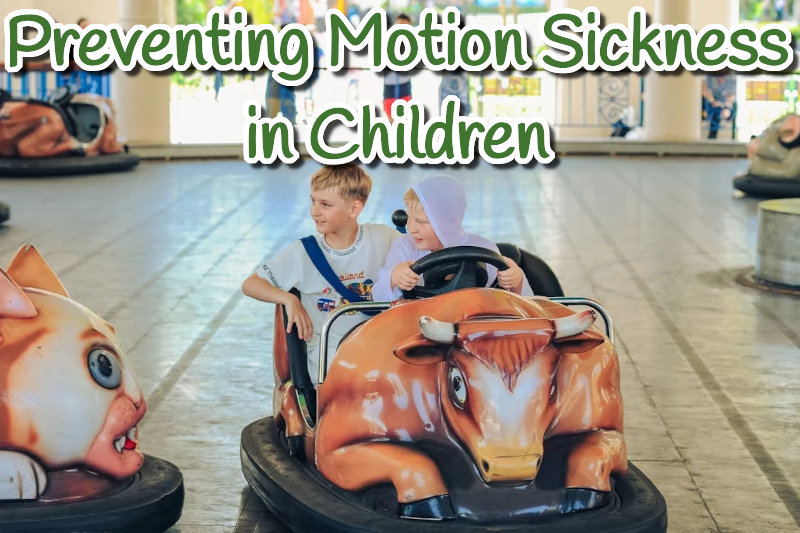Children With Motion Sickness: Parent Tips to Prevent Nausea for Travel in 2025

May 3rd, 2025 | Nausea, New Mothers
Traveling with kids is an adventure—sometimes filled with laughter, sometimes with backseat grumbles—and for some families, motion sickness can turn an outing upside down. Children with motion sickness may experience nausea, dizziness, headaches, or even vomiting. These episodes can come on fast and hit hard, making family travel stressful for both kids and parents. Fortunately, there are practical strategies to help prevent and manage motion sickness, so family journeys can be smoother for everyone.
Understanding Motion Sickness in Children
Motion sickness happens when the brain receives mixed signals from the inner ear, eyes, and body. While in a moving car, boat, or plane, a child’s inner ear senses motion, but their eyes may focus on something still, like a book or a movie. This sensory mismatch confuses the brain and triggers classic symptoms—nausea, pale skin, cold sweats, fatigue, and sometimes vomiting.
Children are more sensitive to these conflicting signals, especially ages 2 to 12, which is why children with motion sickness are a common concern for families. According to pediatric health experts, up to 58% of children report some symptoms of motion sickness, especially during car or boat trips. Some kids may even develop a fear of travel due to repeated episodes, leading to anxiety before each journey.
Certain signs can tip parents off early:
- Unusual yawning or restlessness
- Complaints of stomach aches
- Excessive drooling
- Increased irritability or general discomfort
If you need more background on treatment paths for these scenarios, see this guide on Ginger Capsules for Motion Sickness.
Effective Prevention and Management Strategies for Parents
Managing motion sickness doesn’t mean giving up on family trips. Simple planning, a few tweaks in routine, and the right tools can help your child enjoy the ride. Below are proven tips for parents to keep children with motion sickness comfortable and calm.
Managing Motion Sickness Tips can also help for quick reference.
Preparing for Travel: Planning Ahead
Preparation is key.
- Pick travel times wisely. Starting fresh in the morning, when kids are rested and hunger is satisfied, can help.
- Light meals work best. Offer easy-to-digest snacks before and during trips—think dry cereal, bananas, or crackers. Avoid greasy, spicy foods and heavy meals just before departure.
- Stay hydrated. Small, frequent sips of water or clear liquids reduce dehydration risk, which can worsen nausea.
- Pack smart. Bring wipes, plastic bags, extra clothes, and favorite cleaning supplies within reach for quick cleanups.
For summer road trips, see these Tips to Combat Summer Motion Sickness for season-specific advice.
Comfort Measures and Positioning During Journeys
Where your child sits and what they do during the ride matter.
- Best seat picks: The middle back seat (for cars) or a seat over the wing (for planes) offers the smoothest ride.
- Look ahead: Encourage eyes on the horizon, not screens or books. Window gazing can help match visual cues with motion, reducing confusion in the brain.
- Good airflow: Open windows or use air vents for a gentle breeze. Fresh air often calms queasy stomachs.
- Breaks help. Stop every hour or two for a quick stretch, a bathroom run, and some deep breaths outside.
- Bring comfort items: A favorite blanket, plushie, or playlist can distract and soothe.
Natural and Medical Remedies: What Works for Kids
Not every remedy suits every child, so it’s smart to talk with your pediatrician about the safest options.
Natural options:
- Ginger: Studies have shown ginger can help with nausea. Ginger chews, lozenges, or capsules may work for some children (with medical sign-off).
- Acupressure bands: These wristbands, which apply gentle pressure to specific points, have given relief to some kids.
- Mint: Sipping a bit of peppermint tea or sucking on a peppermint hard candy can settle upset tummies for older children.
Medication:
- Only use medications (like dimenhydrinate or meclizine) with a doctor’s guidance.
- Start the first dose 30-60 minutes before travel if approved by your physician.
Behavioral approaches:
- Practice relaxation and slow breaths to ease anxiety.
- Small distractions like music or gentle conversation can shift focus and curb symptoms.
Always check every label and direction—what’s safe for one child may not suit another. Some motion sickness products specifically for kids are available without a prescription, but confirm with your child’s provider before using anything new.
Conclusion
Caring for children with motion sickness isn’t easy, but with the right preparation, you can keep symptoms brief and manageable. Parents who learn their child’s triggers and use smart prevention strategies can make trips much more pleasant. Keeping snacks gentle, seating strategic, and remedies at hand can transform dreaded car rides into happy family memories. If you’re looking for more tips on parenting or support during challenging times, see New Mothers Resources for guidance and ideas.
Every child is different—but with patience and a clear plan, your family can enjoy time on the road, rails, or sea, free from motion sickness drama.
Recent Posts
- Struggling with Chemotherapy Over the Holidays
- Navigating the Holidays with Ease: Managing Travel Sickness While Enjoying the Feasts
- Holiday Travel With Morning Sickness: A Calm Traveler’s Guide
- The Friendly Guide to Keeping Pregnancy Nausea at Bay
- Beat the Morning Sickness Blues: DIY Ginger Remedies for a Calmer Pregnancy
Categories
- All-Natural (4)
- Blog (47)
- Cancer (72)
- Diet (15)
- Holidays (22)
- Lifestyle (67)
- Motion Sickness (44)
- Nausea (102)
- New Mothers (34)
- Oncology Testimonials (3)
- Prebiotics (1)
- Preggie Products (5)
- Preggie Testimonial (23)
- Pregnancy (155)
- Queasy Products (5)
- Queasy Testimonial (17)
